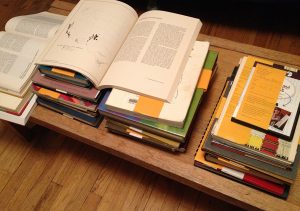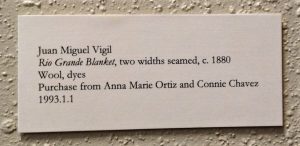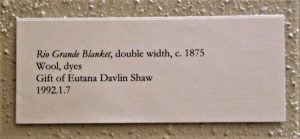When I began working on the Rio Grande textiles exhibit, I had no title for the exhibit because as yet I knew virtually nothing about the topic. Although I had begun reading books and journal articles about the textiles, initially I learned the most from my first visit to the Millicent Rogers Museum and their exhibit “A Feast for the Eyes, Rio Grande Blankets from the Collection.” In this exhibit I saw in detail the reality of what was discussed in the books and in another exhibit I saw a European horizontal treadle loom like those used to weave these blankets.

Research materials
With this visual connection, my understanding quickly expanded as I continued to research. And the more I read, the more the political, economic, social, and cultural context became crucial to appreciating the role of the blankets in the expansion of Spanish culture throughout the American Southwest and the interactions with Mexico and Native Americans of the era.
I identified key areas of interest and focused research on these topics, which were later developed into several of the interpretive labels for the exhibit and also a visitor take-away sheet. As I researched, I was also developing a report on the textiles, which inadvertently turned into a full-blown research paper because there was so much information that helped to explain the significance of these textiles in the Hispanic culture of the time. I was truly fascinated. It was through all of this research that the title for the exhibit emerged: “Rio Grande Blankets: Hispanic History and Tradition.”


